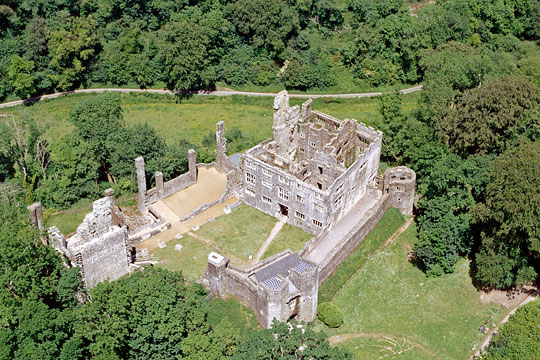Description of Berry Pomeroy Castle
Among the most picturesque and romantic ruins in England, Berry Pomeroy Castle stands in Devon woodland, on a promontory overlooking the steep-sided valley of the Gatcombe brook.

Medieval Defences
The earliest remains visible today, a defended residence with a dry moat, date from the late 15th century. The original defences survive along the south-east side of the site and include a gatehouse, corner tower (St Margaret’s Tower) and connecting curtain wall, which continues for short distances along the south-west and north-east sides. There are remnants of another corner tower at the north-east angle.
The defences, though incomplete, include nine purpose-built cannon ports, three of them multiple, and at least ten plain ‘loops’ for handguns. The six gunports in the ground floor of the gatehouse towers are notable for their wide internal splays for maximum gun-traverse, and their careful positioning to cover the greatest possible fields of fire.
Within the gatehouse is a medieval wall painting, discovered in 1978, and dated to about 1490–1500. The painting, depicting the visit of the Three Magi to Bethlehem, had clearly served as the reredos (ornamental screen) for an altar set beneath the east-facing window below. This corner of the chamber may thus have housed a private family oratory, or less probably the whole chamber was the castle chapel.
The Elizabethan Mansion
The remains of the Elizabethan mansion, built within the 15th-century defences in the 1560s, stand four storeys high to roof level. Originally built round three sides of a courtyard, the house was compact and very tall, with two complete floors of accommodation above the hall and services. After about 1590 the fourth, eastern side of the courtyard was infilled with an additional range, in a noticeably darker red stone and with plainer window surrounds.
The Jacobean Wing
To the north of the Elizabethan mansion are the remains of the immense Jacobean north wing, part of a grandiose scheme to enlarge the house begun in about 1600 but never finished. A magnificent three-storey state range was built along the north-west side of the site, extending beyond the limits of the old defences.
This contained a great hall, massive staterooms and chambers sumptuously decorated in marble and alabaster, and a long gallery on the top floor. On the courtyard side was a Classical loggia surmounted by a balcony.
Terraces were begun at both ends of this range and another was planned on its north-west side, overlooking ponds in the valley below, but these were abandoned before completion. Vast kitchens at the western end, with even more chambers above, were the beginnings of an equally tall west wing, planned to extend over the infilled moat along this side of the site; but this wing was never finished.
The abrupt halt to these building works is dramatically apparent not only from the unfinished west wing, but also from the outcrops of rough bedrock left uncleared in front of the grand loggia.
READ MORE ABOUT BERRY POMEROY CASTLE